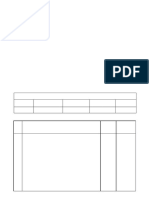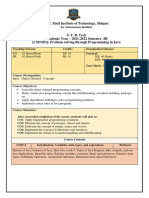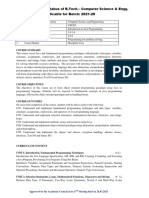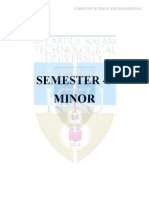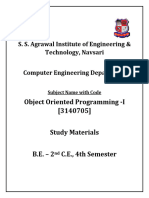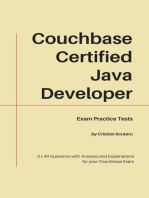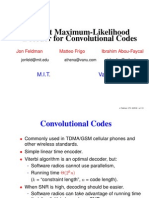Syllabus Java
Uploaded by
wasimrajaaSyllabus Java
Uploaded by
wasimrajaa23CY201 JAVA PROGRAMMING 1/0/4/3
Nature of Course F (Theory Programming)
Pre requisites -
Course Objectives:
1 To understand the basic concepts of core java.
2 To employ different types of modifiers and Control statements
3 To implement and interpret Arrays and Strings concepts
4 To implement streams and java console formatting features
Course Outcomes :
Upon completion of the course, students shall have ability to
C201.1 Infer the basic concepts of java programming. [U]
C201.2 Illustrate the usage of different aspects of Controls statements in real world scenarios. [AP]
C201.3 Apply Array and strings in real time environment. [AP]
C201.4 Analyse and Interpret StringBuffer and StringBuilder Classes [A]
C201.5 Utilize the functionalities of streams and java console class. [AP]
Course Contents:
MODULE I Introduction to Java 15 hours
Introduction to Java: Java Architecture- JVM, JRE & JDK, Keywords, Features of Java, Console input and output
statements, variables and Identifiers, Scope of Variables, Data types, Type Conversion, Comments, Command
Line Arguments, Access Modifiers Operators - Unary Operator- Arithmetic Operator- Shift Operator - Relational
Operator - Bitwise Operator - Logical Operator - Ternary Operator and Assignment Operator. Decision
Statements - if Statements, if-else Branching, switch Statements.
MODULE II Loops, Array & Strings 15 Hours
Looping Statements: using for loop, using while Loops, Using do Loops. Jump Statements: using break and
continue, Unlabelled Statements, Labelled Statements. Arrays: Declaration, Instantiation and Initialization of Java
Array, Types of Array - Single Dimension array, Multi-dimension array - Strings: String, StringBuilder, and
StringBuffer, The String Class, Important Facts About Strings and Memory, Important Methods in the String Class,
The StringBuffer and StringBuilder Classes, Important Methods in the StringBuffer and StringBuilder Classes, File
Navigation and I/O.
MODULE III Java I/O 15 Hours
Streams: Types of Streams, The Byte-stream I/O hierarchy, Character Stream Hierarchy, Random Access File
class, The java.io.Console Class, Serialization, Dates, Numbers, and Currency, Working with Dates, Numbers,
and Currencies, Parsing, Tokenizing, and Formatting, Locating Data via Pattern Matching, Tokenizing.
Total Hours 45
List of Component:
S. No. Lab Exercises
1 Implementation of simple java program using Command Line Arguments
2 Implementation of simple java programs using decision making statements
3 Implementation of simple java programs using Looping statements
4 Implementation of Simple java programs using Jump statements
5 Implementation of 1D Array
6 Implementation of 2D Array
7 Implementation of String functions
8 Implementation of simple java program using Streams
9 Implementation of simple java program using Date and Number classes
10 Implementation of simple java program using Tokenizing
Total Hours 30
Text Books:
1. Herbert Schildt, “Java: The Complete Reference”, 9th edition, Tata McGraw Hill, 2014.
2. Kathy Sierra, “Head First Java: A Brain-Friendly Guide, 2nd Edition, Oreilly, 2009.
3. Herbert Schildt, “Java A Beginner's Guide, Create, Compile and Run Java Programs Today”, 8th edition,
Tata McGraw Hill, 2020.
Reference Books:
1. Paul Deitel, Harvey Deitel, ”Java How To Program”, 10th Edition, Prentice Hall Publications, 2014.
2. Y. Daniel Liang, ”Introduction to Java Programming”, 9th Edition, Prentice Hall Publications, 2015.
3. Ed Roman, RIma Patel, Sriganesh, Gerald Brose, “Mastering Enterprise JavaBeans” 3rd edition, Wikely,
2005.
Web References:
1 http://www.nptel.ac.in
2 http://www.javaworld.com
3 https://www.learnjavaonline.org/
4 https://www.codecademy.com/learn/learn-java
Online Resources:
1 https://www.coursera.org/courses?query=java
2 https://www.tutorialspoint.com/java/index.htm
3 https://www.w3schools.com/java/java_intro.asp
Continuous Assessment
Theory Practical End
Total Semester
Formati Summa Format Total
Summati Continuous Practical Total
ve tive Tot Total ive ve Total (A+ Examinat
Assessmen ion
Assess Assess al (A) Assess Assess (B) B)
t
ment ment ment ment
80 120 200 100 75 25 100 200 50 50 100
Formative Assessment based on Capstone Model – Theory
FA (10%)
Course Outcome Bloom’s Level Assessment Component
[80 Marks]
C201.1 Apply Quiz & Assignment 20
C201.2 Apply Assignment 20
C201.3 Apply Case study 20
C201.4 Analyze 20
Group Assignment
C201.5 Analyze 20
Assessment based on Summative Assessment – Theory
Summative Assessment (15%)
Bloom’s Level [120 Marks]
CIA1: (60 Marks) CIA2: (60 Marks)
Remember - -
Understand 20 -
Apply 80 80
Analyse - 20
Evaluate - -
Create - -
Assessment based on Continuous and End Semester Examination - Practical
Continuous Assessment (25%) End Semester Examination
Bloom’s Level [100 Marks] (50%)
FA: (75 Marks) SA: (25 Marks) [100 Marks]
Remember - -
Understand 20 - 10
Apply 80 80 80
Analyze - 20 10
Evaluate - - -
Create - - -
Assessment based on Continuous and End Semester Examination
Continuous Assessment (50%)
CA 1 CA 2 Practical Exam
End
(100 Marks) (100 Marks) (100 Marks)
Semester
FA 1 FA 2 Practical
Component- FA Examination
SA 1 Component-I Component-II SA 2 Component-I SA (50%)
II
(60M) (60M) (75M) (25M)
(20 Marks) (20 Marks) (20 Marks)
(20 Marks)
Programme Specific
Programme Outcomes (PO)
Course Outcome (CO) Outcomes (PSO)
1 2 3 4 5 6 7 8 9 10 11 12 1 2 3
C201.1 2 2 2 - - - - 2 - - 2 2 - 2
C201.2 3 3 3 - - - - 2 2 2 - 2 2 2 2
C201.3 2 2 3 - 2 - - 2 - - 3 - - 3
C201.4 3 2 2 - 2 - - 2 2 2 - 3 - 2 3
C201.5 3 2 2 - 2 - - 2 2 2 - 3 - 2 3
You might also like
- Hourglass Workout Program by Luisagiuliet 276% (21)Hourglass Workout Program by Luisagiuliet 251 pages
- Read People Like A Book by Patrick King-Edited57% (82)Read People Like A Book by Patrick King-Edited12 pages
- Livingood, Blake - Livingood Daily Your 21-Day Guide To Experience Real Health77% (13)Livingood, Blake - Livingood Daily Your 21-Day Guide To Experience Real Health260 pages
- Donald Trump & Jeffrey Epstein Rape Lawsuit and Affidavits83% (1016)Donald Trump & Jeffrey Epstein Rape Lawsuit and Affidavits13 pages
- The 36 Questions That Lead To Love - The New York Times94% (34)The 36 Questions That Lead To Love - The New York Times3 pages
- The 36 Questions That Lead To Love - The New York Times95% (21)The 36 Questions That Lead To Love - The New York Times3 pages
- Jeffrey Epstein39s Little Black Book Unredacted PDF75% (12)Jeffrey Epstein39s Little Black Book Unredacted PDF95 pages
- 14 Easiest & Hardest Muscles To Build (Ranked With Solutions)100% (8)14 Easiest & Hardest Muscles To Build (Ranked With Solutions)27 pages
- The 4 Hour Workweek, Expanded and Updated by Timothy Ferriss - Excerpt23% (954)The 4 Hour Workweek, Expanded and Updated by Timothy Ferriss - Excerpt38 pages
- Candy Construction Planning and ProgrammingNo ratings yetCandy Construction Planning and Programming135 pages
- Object Oriented Programming Concepts Using JavaNo ratings yetObject Oriented Programming Concepts Using Java2 pages
- Silver Oak University: College of TechnologyNo ratings yetSilver Oak University: College of Technology5 pages
- CSE2005_OBJECT-ORIENTED-PROGRAMMING-USING-JAVA_ETH_4.1_15_CSE2005 - Object Oriented Programming using JAVA_Revised-4.1 (B.Tech-UC)No ratings yetCSE2005_OBJECT-ORIENTED-PROGRAMMING-USING-JAVA_ETH_4.1_15_CSE2005 - Object Oriented Programming using JAVA_Revised-4.1 (B.Tech-UC)3 pages
- Circular_20241130163421_Cho_23cs005_prgramming_In_JavaNo ratings yetCircular_20241130163421_Cho_23cs005_prgramming_In_Java9 pages
- CE505 - Object Oriented Programming With JAVANo ratings yetCE505 - Object Oriented Programming With JAVA3 pages
- OOP in Java BCA Syllabus IT College NepalNo ratings yetOOP in Java BCA Syllabus IT College Nepal4 pages
- Object Oriented Programming through JAVANo ratings yetObject Oriented Programming through JAVA3 pages
- OOPJ_R23_II-I_MicroSylllabusFinalModelPaperNo ratings yetOOPJ_R23_II-I_MicroSylllabusFinalModelPaper8 pages
- Pla1001 Programming-For-Computing-Engineers LT 1.0 7 Pla1001No ratings yetPla1001 Programming-For-Computing-Engineers LT 1.0 7 Pla10013 pages
- Thiruvalluvaruniversity Bachelor of Computer Applications Degree Course Cbcs Pattern (With Effect From 2020-2021)No ratings yetThiruvalluvaruniversity Bachelor of Computer Applications Degree Course Cbcs Pattern (With Effect From 2020-2021)70 pages
- Course-Outline of Java Programming CS 403No ratings yetCourse-Outline of Java Programming CS 4039 pages
- Lab Manual Data Structures Using JAVA-R1UC303BNo ratings yetLab Manual Data Structures Using JAVA-R1UC303B33 pages
- WINSEMFRE2024-25_SWE2005_ETH_AP2024255000728_2025-01-28_Reference-Material-INo ratings yetWINSEMFRE2024-25_SWE2005_ETH_AP2024255000728_2025-01-28_Reference-Material-I3 pages
- 5th Sem Syllabus (ICT 455 Java Programming)No ratings yet5th Sem Syllabus (ICT 455 Java Programming)3 pages
- Raisoni TYBBA (CA) Sem V LabBook of Java & PythonNo ratings yetRaisoni TYBBA (CA) Sem V LabBook of Java & Python68 pages
- 22CS202 Java Programming Unit 1 Digital NotesNo ratings yet22CS202 Java Programming Unit 1 Digital Notes90 pages
- Lesson Plan - Object-Oriented Programming Using JavaNo ratings yetLesson Plan - Object-Oriented Programming Using Java4 pages
- Cse310 - Modern Programming Tools and Techniques-I0% (1)Cse310 - Modern Programming Tools and Techniques-I7 pages
- The C++ Workshop: Learn to write clean, maintainable code in C++ and advance your career in software engineeringFrom EverandThe C++ Workshop: Learn to write clean, maintainable code in C++ and advance your career in software engineeringNo ratings yet
- Introduction To Unix: Common To Solaris - HushaNo ratings yetIntroduction To Unix: Common To Solaris - Husha20 pages
- How To Configure and Use Automatic Updates in Windows: Support Store ProductsNo ratings yetHow To Configure and Use Automatic Updates in Windows: Support Store Products10 pages
- Instruction Manual: Energy Management SoftwareNo ratings yetInstruction Manual: Energy Management Software206 pages
- Quality Control System in The Fabrication of Heat ExchangersNo ratings yetQuality Control System in The Fabrication of Heat Exchangers5 pages






































